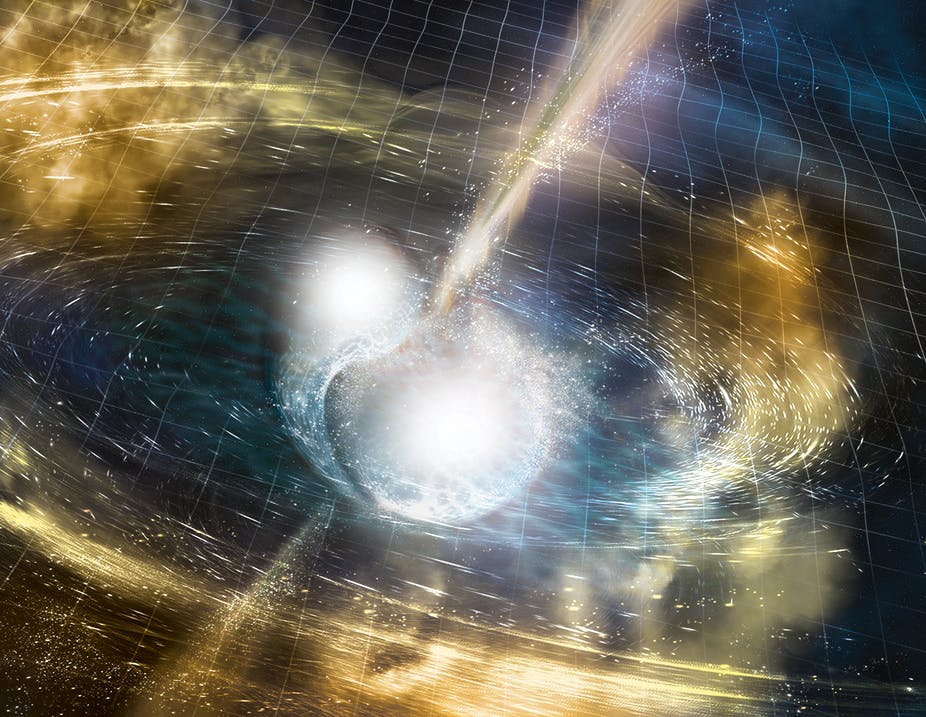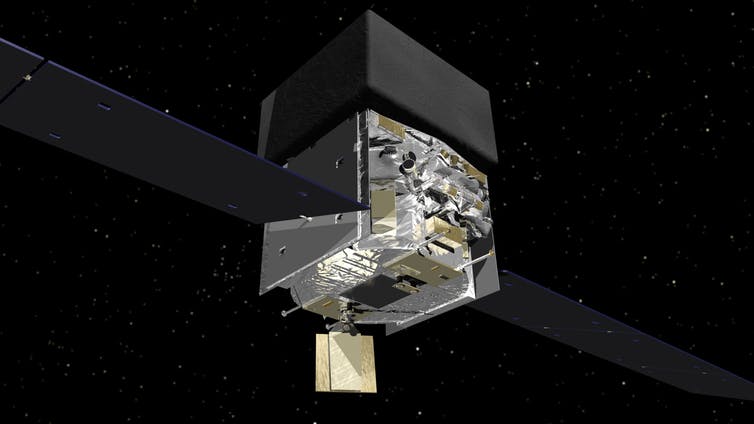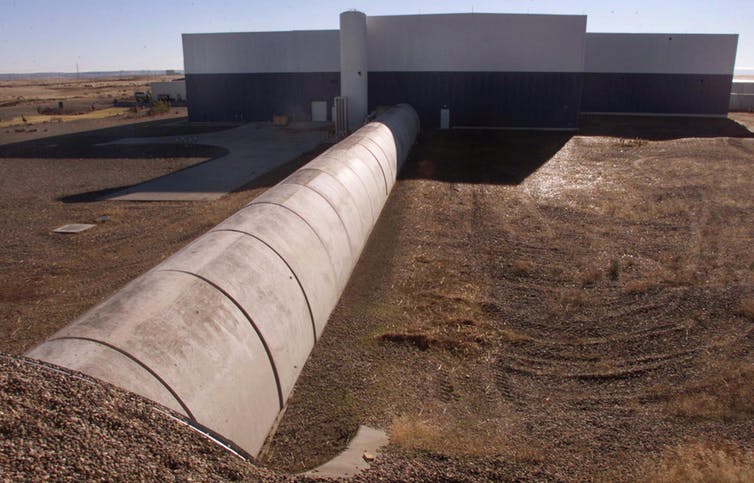How We Discovered Gravitational Waves from ‘Neutron Stars’ – And Why It’s Such a Huge Deal
SCIENCE, 23 Oct 2017
Martin Hendry – The Conversation

Artist’s illustration of two merging neutron stars.
National Science Foundation/LIGO/Sonoma State University/A. Simonnet., CC BY-SA
16 Oct 2017 – Rumours have been swirling for weeks that scientists have detected gravitational waves – tiny ripples in space and time – from a source other than colliding black holes. Now we can finally confirm that we’ve observed such waves produced by the violent collision of two massive, ultra-dense stars more than 100m light years from the Earth.
The discovery was made on August 17 by the global network of advanced gravitational-wave interferometers – comprising the twin LIGO detectors in the US and their European cousin, Virgo, in Italy. It is hugely important, not least because it helps solve some big mysteries in astrophysics – including the cause of bright flashes of light known as “gamma ray bursts” and perhaps even the origins of heavy elements such as gold.
As a member of the LIGO scientific collaboration, I was immediately in raptures as soon as I saw the initial data. And the period that followed was definitely the most intense and sleep deprived, but also incredibly exciting, two months of my career.
The announcement comes just weeks after three scientists were awarded the Nobel Prize in Physics for their foundational work leading to the discovery of gravitational waves, first announced in February 2016. Since then, detecting gravitational waves from colliding black holes has started to feel like familiar territory – with four further such events detected. But as far as we know, colliding black holes offer purely a window on the dark side of the universe. We haven’t been able to register light from these events with any other instruments.
But GW170817 – the catchy title for the event of August 17 — changes all that. That’s because the source of the waves this time was two “neutron stars” – incredibly dense stellar remnants the size of a city, each weighing more than the sun. These stars whizzed around each other at a sizeable fraction of the speed of light before merging in a cataclysmic collision that we’ve now seen shake the very fabric of space and time.
Mysteries solved
The cosmic concerto was just beginning, however. Astronomers have long suspected that the merger of two neutron stars could be the overture to a short gamma ray burst – an intense flash of gamma-ray light that releases more energy in a fraction of a second than the sun will pump out in ten billion years. For several decades we have observed these gamma ray bursts, but without knowing for sure what causes them.
However, just 1.7 seconds after the gravitational waves from GW170817 arrived at the Earth, NASA’s Fermi satellite observed a short burst of gamma rays in the same general region of the sky. LIGO and Virgo had found the smoking gun, and the link between neutron star collisions and short gamma ray bursts was finally and clearly established.

Many hands make light (and gravity) work. NASA’s Fermi satellite was instrumental in the discovery. NASA
The combination of gravitational-wave and gamma-ray observations allowed the position of the cosmic explosion to be pinpointed to less than 30 square degrees on the sky – or about 100 times the size of the full moon. This, in turn, allowed a whole barrage of astronomical telescopes sensitive to light across the entire electromagnetic spectrum to search this small patch of sky for the aftermath of the explosion. And sure enough this was found – in an unfashionable backwater towards the edge of a fairly unassuming galaxy called NGC4993, in the constellation of Hydra.
Over the next few days and weeks astronomers watched agog as the embers from the explosion glowed brightly and faded, beautifully matching the pattern expected for a so-called “kilonova”. This is produced when material rich in subatomic particles known as neutrons from the initial merger is ejected at great speed by the gamma ray burst. This ploughs into the surrounding region of space, triggering the production of heavy radioactive elements.
These unstable elements typically split up (decay) to a stable state by emitting radiation. This is what causes the glow of the kilonova, which we have now confirmed by mapping it out in exquisite detail. Our observations also strongly support the theory that the stable end-products of these chains of reactions include copious amounts of precious metals like gold and platinum. While we’ve suspected neutron stars to be key to producing these elements in space, that hypothesis now looks a whole lot more convincing. Indeed, the kilonova that formed from the embers of GW170817 could have produced as much gold as the entire mass of the Earth – that is 1,000 trillion tonnes.
What is a binary neutron star? @Martin_astro tells us about one of the most bizarre objects in the universe. #GoldenBinary pic.twitter.com/AzHTReV8Z7
— University of Glasgow (@UofGlasgow) October 16, 2017
By observing a kilonova “up close and personal” for the very first time, and seeing how well it fits into the unfolding astronomical storyboard that began with the neutron star merger, astronomers have taken a huge leap forward in our understanding of these violent cosmic events.
The idea that we are all made of stardust is increasingly appreciated in popular culture – in everything from documentaries to song lyrics. But the mind-blowing concept that the gold in our wedding rings and Rolex watches is made of neutron stardust is about to catch on. Perhaps even more exciting, however, is the enormous potential now unlocked by this radical, new approach to studying the cosmos.
By working together collaboratively – using instruments that operate not just across the entire spectrum of light but are sensitive to gravitational waves and even neutrinos too – astronomers are poised to fully open a completely new “multi-messenger” window on the universe, with many further discoveries to be made and cosmic mysteries to be solved. For example, we have already used our observations to make the first ever joint measurement of the expansion rate of the universe, using both gravitational waves and light. Our paper will appear in Nature on October 16.
More results will also surely follow soon. The exciting new era of multi-messenger astronomy just started with a bang.
_________________________________________
 Martin Hendry – Professor of Gravitational Astrophysics and Cosmology, University of Glasgow
Martin Hendry – Professor of Gravitational Astrophysics and Cosmology, University of Glasgow
Republish The Conversation articles for free, online or in print, under Creative Commons license.
Go to Original – theconversation.com
DISCLAIMER: The statements, views and opinions expressed in pieces republished here are solely those of the authors and do not necessarily represent those of TMS. In accordance with title 17 U.S.C. section 107, this material is distributed without profit to those who have expressed a prior interest in receiving the included information for research and educational purposes. TMS has no affiliation whatsoever with the originator of this article nor is TMS endorsed or sponsored by the originator. “GO TO ORIGINAL” links are provided as a convenience to our readers and allow for verification of authenticity. However, as originating pages are often updated by their originating host sites, the versions posted may not match the versions our readers view when clicking the “GO TO ORIGINAL” links. This site contains copyrighted material the use of which has not always been specifically authorized by the copyright owner. We are making such material available in our efforts to advance understanding of environmental, political, human rights, economic, democracy, scientific, and social justice issues, etc. We believe this constitutes a ‘fair use’ of any such copyrighted material as provided for in section 107 of the US Copyright Law. In accordance with Title 17 U.S.C. Section 107, the material on this site is distributed without profit to those who have expressed a prior interest in receiving the included information for research and educational purposes. For more information go to: http://www.law.cornell.edu/uscode/17/107.shtml. If you wish to use copyrighted material from this site for purposes of your own that go beyond ‘fair use’, you must obtain permission from the copyright owner.
